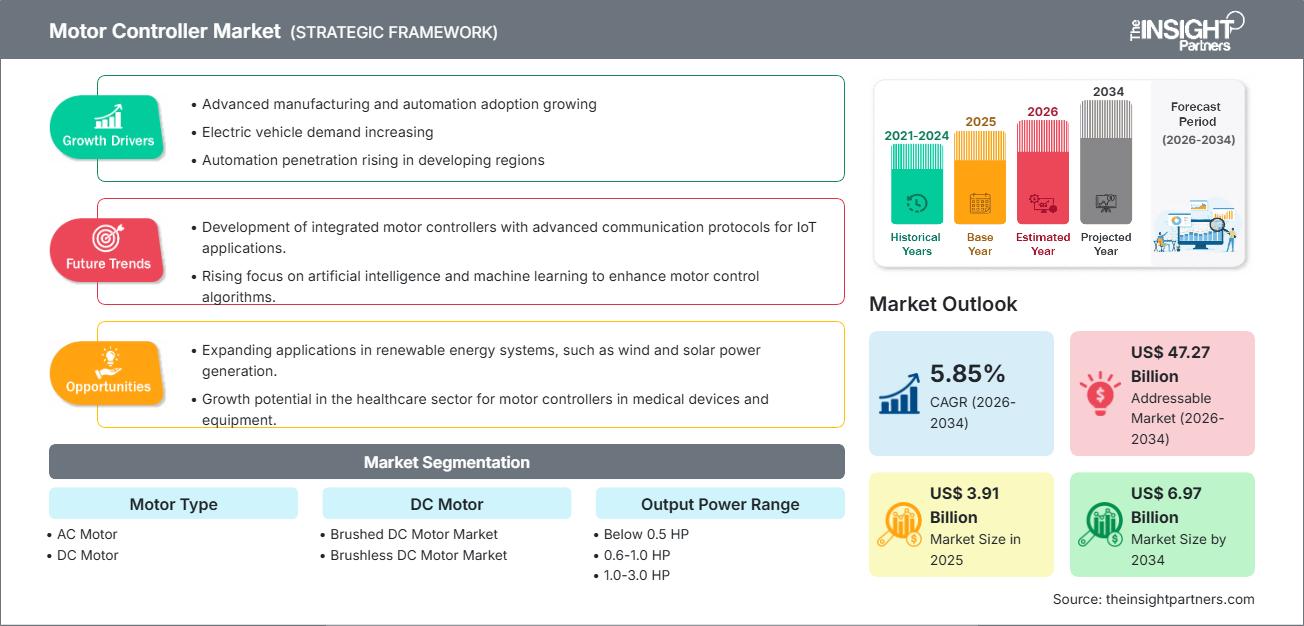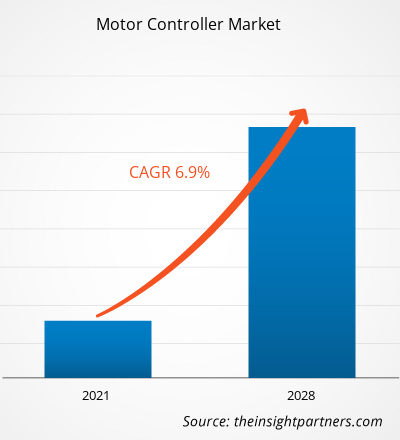Der globale Markt für Motorsteuerungen wird voraussichtlich deutlich wachsen und bis 2034 ein Volumen von 6,97 Milliarden US-Dollar erreichen, gegenüber 3,91 Milliarden US-Dollar im Jahr 2025. Es wird erwartet, dass dieses Wachstum im Prognosezeitraum 2026–2034 eine durchschnittliche jährliche Wachstumsrate (CAGR) von 5,85 % erreichen wird.
Marktübersicht und -analyse
Die Marktprognose für Motorsteuerungen deutet auf ein signifikantes Wachstum hin, angetrieben durch den massiven Wandel hin zu industrieller Automatisierung und intelligenter Fertigung, die zunehmende Verbreitung von Elektrofahrzeugen (EVs) sowie strenge globale Vorgaben zu Energieeffizienz und Nachhaltigkeit. Unterstützt wird dieses Wachstum durch die Einführung verbesserter Steuerungen mit fortschrittlichen Funktionen wie drahtloser Konnektivität, Edge Computing und KI-gestützter Optimierung. Diese neuen Funktionalitäten ermöglichen wie vorausschauende Wartung, Echtzeitüberwachung und die nahtlose Integration in IoT-Systeme und tragen so zu einer Steigerung der betrieblichen Effizienz und Präzision bei.
Marktübersicht für Motorsteuerungen
Die Motorsteuerung ist ein elektronisches Gerät, das die Leistung eines Elektromotors durch die Regelung wesentlicher Betriebsparameter wie Drehzahl, Drehmoment und Position steuert. Diese Systeme sind unerlässlich für präzises Arbeiten, höhere Energieeffizienz und mehr Sicherheit in einer Vielzahl von Anwendungen, darunter Industrieroboter, Fahrzeugantriebe und Haushaltsgeräte. Die Steuerungen optimieren die Motorleistung und minimieren Energieverluste, um die Lebensdauer der Geräte zu verlängern. Damit sind sie ein grundlegender Baustein im globalen Trend hin zu effizienter und nachhaltiger Elektrifizierung – sowohl in kleinen Konsumgütern als auch in der industriellen Infrastruktur.
Passen Sie diesen Bericht Ihren Anforderungen an.
Sie erhalten eine kostenlose Anpassung aller Berichte – einschließlich Teilen dieser Berichte, Länderanalysen und Excel-Datenpaketen – sowie attraktive Angebote und Rabatte für Start-ups und Universitäten.
Markt für Motorsteuerungen: Strategische Einblicke

-
Ermitteln Sie die wichtigsten Markttrends dieses Berichts.Diese KOSTENLOSE Probe beinhaltet eine Datenanalyse, die von Markttrends bis hin zu Schätzungen und Prognosen reicht.
Markttreiber und Chancen für Motorsteuerungen
Markttreiber
- Weltweit zunehmende Verbreitung von Elektrofahrzeugen: Die Durchdringung von Elektrofahrzeugen ist ein wichtiger Katalysator, der hochentwickelte Motorsteuerungssysteme erfordert.
- Zunehmende industrielle Automatisierung und intelligente Fertigung: Steuerungen sind integrale Bestandteile von Robotik- und automatisierten Industriesystemen.
- Zunehmender Fokus auf Energieeffizienz und Nachhaltigkeit: Regulatorische Maßnahmen und Kosteneinsparungsinitiativen treiben den Bedarf an effizienter Steuerung voran.
Marktchancen
- Integration von IoT und KI in Motorsteuerungssysteme: Dies ermöglicht vorausschauende Diagnosefunktionen und einen intelligenten, effizienteren Betrieb.
- Expansion in Schwellenländern: Die rasante Industrialisierung in Regionen wie dem asiatisch-pazifischen Raum und Lateinamerika bietet ein starkes, bisher ungenutztes Potenzial.
- Entwicklung fortschrittlicher Steuerungen für erneuerbare Energien: Wind- und Solarenergiesysteme erfordern eine präzise Steuerung der Motoren, um die Energieerzeugung zu optimieren.
Marktbericht für Motorsteuerungen: Segmentierungsanalyse
Der Marktanteil von Motorsteuerungen wird in verschiedenen Segmenten analysiert, um ein besseres Verständnis der technologischen Landschaft, der Anwendungsnachfrage und der regionalen Konsummuster zu ermöglichen. Nachfolgend ist der in den meisten Branchenberichten verwendete Standard-Segmentierungsansatz dargestellt:
Nach Motortyp
- Wechselstrommotor: Wechselstrommotorsteuerungen, die hauptsächlich Frequenzumrichter umfassen, bilden aufgrund ihrer hohen Effizienz, präzisen Drehzahlregelung und Skalierbarkeit der Ausgangsleistung das Rückgrat industrieller Anwendungen und sind somit das Rückgrat großer Maschinen, Pumpen und Ventilatoren.
- Gleichstrommotor: Gleichstrommotorsteuerungen werden hauptsächlich in batteriebetriebenen und Niederspannungssystemen eingesetzt. Sie sind einfacher zu implementieren und unerlässlich für Elektrofahrzeuge, leichte Industrieanlagen und Unterhaltungselektronik, wo Mobilität und direktes Energiemanagement erforderlich sind.
Durch Gleichstrommotor
- Markt für gebürstete Gleichstrommotoren: Dieses Segment ist zwar ausgereift, spielt aber immer noch eine Rolle bei kostengünstigen Anwendungen mit geringem Stromverbrauch, bei denen Einfachheit und Wartungsfreundlichkeit Vorrang vor einer langen Lebensdauer haben, wie beispielsweise bei einigen Automobilkomponenten und einfachen Konsumgütern.
- Markt für bürstenlose Gleichstrommotoren (BLDC): BLDC-Motoren zeichnen sich durch höhere Effizienz, Drehmomentdichte und längere Lebensdauer aus und sind daher ein wichtiger Wachstumstreiber für den Markt für BLDC-Controller. Fortschrittliche Robotik, High-End-Elektrofahrzeuge, Drohnen und andere hochwertige Haushaltsgeräte benötigen eine ausgefeilte elektronische Kommutierung.
Nach Ausgangsleistungsbereich
- Unter 0,5 PS
- 0,6–1,0 PS
- 1,0–3,0 PS
- Über 3,0 PS
Die Komplexität des Reglers, die Anforderungen an das Wärmemanagement und die vorgesehenen Anwendungsbereiche werden durch die Segmentierung im Leistungsbereich bestimmt. Regler mit geringerer Leistung werden häufig in Haushaltsgeräten und kleinen Werkzeugen eingesetzt, während Regler mit über 3,0 PS für schwere Industriemaschinen und leistungsstarke Elektrofahrzeuge vorgesehen sind.
Nach Spannungstyp:
- Motoren unter 1 kV
- 1 kV–6,6 kV Motoren
- Mehr als 6,6 kV:
Die Spannungssegmentierung spiegelt die Anforderungen von Industrie und Energieversorgungsunternehmen wider. Niederspannungsregler (unter 1 kV) sind typisch für den Gewerbe- und Verbrauchersektor, während Mittel- und Hochspannungsregler (1 kV und darüber) in großen Pumpen, Kompressoren und Anlagen zur Erzeugung erneuerbarer Energien im Kraftwerksmaßstab, wie beispielsweise großen Windkraftanlagen, eingesetzt werden.
Nach Geographie:
- Nordamerika
- Europa
- Asien-Pazifik
- Süd- und Mittelamerika
- Naher Osten
- Afrika
Jede Region stellt eine einzigartige Mischung aus regulatorischen Rahmenbedingungen und Anforderungen der Endverbraucherindustrie dar, was sich auf die Verbreitungsrate verschiedener Motorsteuerungstechnologien auswirkt.
Markt für Motorsteuerungen – Regionale Einblicke
Die regionalen Trends und Einflussfaktoren auf den Markt für Motorsteuerungen im gesamten Prognosezeitraum wurden von den Analysten von The Insight Partners ausführlich erläutert. Dieser Abschnitt behandelt außerdem die Marktsegmente und die geografische Verteilung des Marktes für Motorsteuerungen in Nordamerika, Europa, Asien-Pazifik, dem Nahen Osten und Afrika sowie Süd- und Mittelamerika.
Marktbericht für Motorsteuerungen – Umfang
| Berichtattribute | Details |
|---|---|
| Marktgröße im Jahr 2025 | 3,91 Milliarden US-Dollar |
| Marktgröße bis 2034 | 6,97 Milliarden US-Dollar |
| Globale durchschnittliche jährliche Wachstumsrate (2026 - 2034) | 5,85 % |
| Historische Daten | 2021-2024 |
| Prognosezeitraum | 2026–2034 |
| Abgedeckte Segmente |
Nach Motortyp
|
| Abgedeckte Regionen und Länder |
Nordamerika
|
| Marktführer und wichtige Unternehmensprofile |
|
Marktdichte der Motorsteuerungsanbieter: Auswirkungen auf die Geschäftsdynamik verstehen
Der Markt für Motorsteuerungen wächst rasant, angetrieben durch die steigende Nachfrage der Endverbraucher. Gründe hierfür sind unter anderem sich wandelnde Verbraucherpräferenzen, technologische Fortschritte und ein wachsendes Bewusstsein für die Vorteile des Produkts. Mit steigender Nachfrage erweitern Unternehmen ihr Angebot, entwickeln innovative Lösungen, um den Kundenbedürfnissen gerecht zu werden, und nutzen neue Trends, was das Marktwachstum zusätzlich beflügelt.

- Verschaffen Sie sich einen Überblick über die wichtigsten Akteure auf dem Markt für Motorsteuerungen.
Marktanteilsanalyse für Motorsteuerungen nach Regionen
Der asiatisch-pazifische Raum wird seine führende Position voraussichtlich auch in den kommenden Jahren behaupten. Die aufstrebenden Märkte in Süd- und Mittelamerika, dem Nahen Osten und Afrika bieten ebenfalls vielversprechendes Wachstumspotenzial für Anbieter von Motorsteuerungen. Der Markt für Motorsteuerungen weist in den einzelnen Regionen unterschiedliche Wachstumsverläufe auf, bedingt durch Faktoren wie Industrialisierungsrate, staatliche Elektrifizierungsvorgaben und den Reifegrad des Automobilsektors. Nachfolgend finden Sie eine Zusammenfassung der Marktanteile und Trends nach Regionen:
Asien-Pazifik
- Marktanteil: Besitzt den größten Marktanteil, was auf die rasche Industrialisierung und die hohe Akzeptanzrate von Elektrofahrzeugen zurückzuführen ist.
- Wichtigste Einflussfaktoren: Staatlich unterstützte Produktionspolitik
- Trends: Fokus auf die Herstellung fortschrittlicher BLDC-Motorsteuerungen und die Implementierung hochpräziser Lösungen für die Fabrikautomation.
Nordamerika
- Marktanteil: Macht einen bedeutenden Anteil aus, was auf hohe Investitionen in Automatisierung und Energieeffizienzvorgaben zurückzuführen ist.
- Wichtigste Treiber: Hohe Investitionen in Industrie-4.0-Technologien, strenge Energiesparvorschriften und starke Robotik- und Luftfahrtsektoren.
- Trends: Rasante Integration von IoT und KI für vorausschauende Wartung und Fernsteuerungsoptimierung in komplexen industriellen Abläufen.
Europa
- Marktanteil: Hält einen bedeutenden Marktanteil, der durch die starke Automobil- und die erneuerbare Energiewirtschaft gestützt wird.
- Wichtigste Treiber: Strenge EU-Emissionsnormen und Elektrifizierungsziele, die zur Nutzung sauberer Energien (Wind/Solar) führen, sowie eine hochwertige, präzise Fertigungsbasis
- Trends: Verlagerung hin zu hochzuverlässigen, sicherheitszertifizierten Steuerungen, die für autonome industrielle Systeme und die Integration von Energiespeichern im Netzmaßstab unerlässlich sind.
Süd- und Mittelamerika
- Marktanteil: Aufstrebender Markt mit zunehmender Industrialisierung.
- Wichtigste Treiber: Ausbau und Modernisierung der Infrastruktur, neue Energie- und Rohstoffgewinnungsprojekte sowie Erweiterung der inländischen Produktionsstätten
- Trends: Nachfrage nach robusten, kostengünstigen Steuerungen für die Rohstoffgewinnung und den Ausbau der Basisproduktion, mit zunehmendem Interesse an Solarenergiesystemen.
Naher Osten und Afrika
- Marktanteil: Entwicklungsmarkt mit starkem Wachstumspotenzial aufgrund steigender Investitionen in Industrie und Versorgungsunternehmen.
- Wichtigste Einflussfaktoren: Nationale Diversifizierungspolitiken, groß angelegte Bau- und Infrastrukturerweiterungen sowie Investitionen in nachhaltigen Verkehr und Wassermanagement
- Trends: Einsatz von Hochleistungsreglern für das Wassermanagement (Entsalzung und Pumpen) und großtechnische Kühl-/HLK-Anwendungen.
Marktdichte der Motorsteuerungsanbieter: Auswirkungen auf die Geschäftsdynamik verstehen
Hohe Marktdichte und starker Wettbewerb
Der Wettbewerb verschärft sich aufgrund der Präsenz großer Anbieter wie ABB Ltd., Eaton Corporation plc und Nidec Corporation. Regionale und spezialisierte Unternehmen wie Microchip Technology Inc. (mit Fokus auf Halbleiter) tragen ebenfalls zu diesem wettbewerbsintensiven Markt bei.
Dieses wettbewerbsintensive Umfeld zwingt die Anbieter dazu, sich durch Folgendes zu differenzieren:
- Verbesserte Standards für funktionale Sicherheit und Zuverlässigkeit für Industrie- und Elektrofahrzeuganwendungen
- Hocheffiziente, kompakte Leistungsmodule für die Hochspannungs-Gleichstrom- und BLDC-Motorsteuerung ·
- KI-gestützte Optimierung für vorausschauende Wartung, Drehmoment- und Drehzahlregelung in Echtzeit
- Nahtlose Integration mit Industrie-4.0-Plattformen, cloudbasierter Überwachung und Edge-Computing-Funktionen
Chancen und strategische Schritte
- Entwicklung und Vermarktung fortschrittlicher Steuerungslösungen für die sich rasch ausdehnende Lade- und Antriebsinfrastruktur für Elektrofahrzeuge (EV).
- Integration von KI/ML in die Antriebsdiagnostik zur Bereitstellung vorausschauender Wartungsdienste und ferngesteuerter Betriebsprognosen.
Die wichtigsten Unternehmen auf dem Markt für Motorsteuerungen sind:
- ABB Ltd.
- AMETEK Inc.
- Eaton Corporation plc
- General Electric Company
- ANAHEIM AUTOMATION, INC
- ARC SYSTEMS INC
- ErieTec Inc
- Microchip Technology Inc.
- Nidec Corporation
Hinweis: Die oben aufgeführten Unternehmen sind nicht in einer bestimmten Reihenfolge geordnet.
Neuigkeiten und aktuelle Entwicklungen auf dem Markt für Motorsteuerungen
- ABB Ltd. hat den Mittelspannungsumrichter ACS8080 mit fortschrittlicher Diagnosefunktion und 98 % Wirkungsgrad vorgestellt: Der Umrichter ACS8080 ist für anspruchsvolle Industrieanwendungen konzipiert und zeichnet sich durch hohe Energieeffizienz und vorausschauende Wartung aus. Diese Innovation unterstreicht die Strategie von ABB, weltweit nachhaltige intelligente und Elektrifizierungslösungen anzubieten.
- AMETEK meldete für das zweite Quartal 2025 einen Rekordumsatz von 1,78 Milliarden US-Dollar und hob die Prognose für das Gesamtjahr an: Die Electromechanical Group verzeichnete einen Umsatzanstieg von 6 % und ein Wachstum des Betriebsergebnisses von 17 % aufgrund der starken Nachfrage nach Produkten zur Bewegungssteuerung.
- Eaton Corporation hat in Zusammenarbeit mit ChargePoint ultraschnelle DC V2X-Ladegeräte auf den Markt gebracht: Die Partnerschaft wird dazu beitragen, die Vehicle-to-Grid-Integration und die Energieresilienz zu beschleunigen und Eatons Engagement für nachhaltige Energiemanagementlösungen zu unterstützen.
- Microchip Technology hat die PIC32-BZ6 MCU-Plattform vorgestellt, die drahtlose Konnektivität und Motorsteuerungsfunktionen integriert: Dieser neue Mikrocontroller ermöglicht kompakte, kostengünstige Designs für industrielle und automobile Anwendungen und kombinierte Konnektivität und Steuerung in einem einzigen Chip.
- Die Nidec Corporation hat ihren Produktionsstandort Orchard Hub in Hubli, Indien, eingeweiht, um die Produktion von EV-Motoren auszuweiten: Die Anlage stärkt die Präsenz von Nidec in Asien und unterstützt die Strategie des Unternehmens, fortschrittliche Motor- und Steuerungssysteme für Elektrofahrzeuge zu liefern.
Marktbericht Motorsteuerungen: Abdeckung und Ergebnisse
Der Bericht „Marktgröße und Prognose für Motorsteuerungen (2021–2031)“ bietet eine detaillierte Analyse des Marktes und deckt folgende Bereiche ab:
- Marktgröße und Prognose für Motorsteuerungen auf globaler, regionaler und Länderebene für alle wichtigen Marktsegmente, die im Geltungsbereich abgedeckt werden
- Markttrends für Motorsteuerungen sowie Marktdynamiken wie Treiber, Hemmnisse und wichtige Chancen
- Detaillierte PEST- und SWOT-Analyse
- Marktanalyse für Motorsteuerungen: Analyse der wichtigsten Markttrends, des globalen und regionalen Rahmens, der Hauptakteure, der regulatorischen Rahmenbedingungen und der jüngsten Marktentwicklungen
- Branchenlandschaft und Wettbewerbsanalyse mit Fokus auf Marktkonzentration, Heatmap-Analyse, führende Akteure und aktuelle Entwicklungen im Markt für Motorsteuerungen
- Detailliertes Unternehmensprofil
- Historische Analyse (2 Jahre), Basisjahr, Prognose (7 Jahre) mit CAGR
- PEST- und SWOT-Analyse
- Marktgröße Wert/Volumen – Global, Regional, Land
- Branchen- und Wettbewerbslandschaft
- Excel-Datensatz
Aktuelle Berichte
Erfahrungsberichte
Grund zum Kauf
- Fundierte Entscheidungsfindung
- Marktdynamik verstehen
- Wettbewerbsanalyse
- Kundeneinblicke
- Marktprognosen
- Risikominimierung
- Strategische Planung
- Investitionsbegründung
- Identifizierung neuer Märkte
- Verbesserung von Marketingstrategien
- Steigerung der Betriebseffizienz
- Anpassung an regulatorische Trends






















 Kostenlose Probe anfordern für - Markt für Motorsteuerungen
Kostenlose Probe anfordern für - Markt für Motorsteuerungen